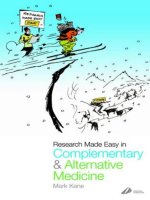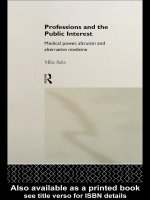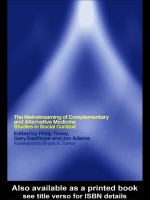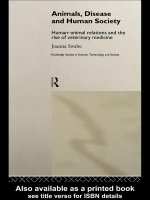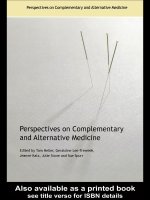The Whole Story Alternative medicine on trial? pot
Bạn đang xem bản rút gọn của tài liệu. Xem và tải ngay bản đầy đủ của tài liệu tại đây (647.11 KB, 191 trang )
The Whole Story
This page intentionally left blank
The Whole Story
Alternative medicine on trial?
Toby Murcott
Macmillan
© Toby Murcott 2005
All rights reserved. No reproduction, copy or transmission of this
publication may be made without written permission.
No paragraph of this publication may be reproduced, copied or transmitted
save with written permission or in accordance with the provisions of the
Copyright, Designs and Patents Act 1988, or under the terms of any licence
permitting limited copying issued by the Copyright Licensing Agency, 90 Tottenham
Court Road, London W1T 4LP.
Any person who does any unauthorised act in relation to this publication may be
liable to criminal prosecution and civil claims for damages.
The author has asserted his right to be identified as the author of this work in accor-
dance with the Copyright, Designs and Patents Act 1988
First published 2005 by
Macmillan
Houndmills, Basingstoke, Hampshire RG21 6XS and
175 Fifth Avenue, New York, N. Y. 10010
Companies and representatives throughout the world
ISBN-13: 978–1–4039–4500–6
ISBN-10: 1–4039–4500–4
This book is printed on paper suitable for recycling and made from fully managed
and sustained forest sources.
A catalogue record for this book is available from the British Library.
A catalog record for this book is available from the Library of Congress.
10987654321
14 13 12 11 10 09 08 07 06 05
Printed and bound in China
Dedicated to the memory of my father,
Ken Murcott (1939–2004)
This page intentionally left blank
Contents
acknowledgements ix
preface xi
1. introduction 1
2. medicine’s conundrum 19
3. the advocates 35
4. the critics 52
5. the gold standard tarnished 70
6. measuring the unmeasurable 94
7. hints of understanding 111
8. a new model 125
9. the evidence leads 140
10. conclusion 158
further reading 164
index 168
vii
This page intentionally left blank
acknowledgements
This book needed to feature a wide range of topics and ideas in
which I can claim no expertise. Therefore I owe a great many
thanks to the specialists who have been so generous with their
time and thoughts. When I have got it right, it is they who have
made it so. Any remaining mistakes are mine and mine alone.
I have had numerous conversations with many people,
either by phone or email, all of whom have contributed in
some way – sometimes explicitly as acknowledged in the text,
sometimes by keeping me on the right track. For these con-
versations I would like to thank Bernadette Carter, Iain
Chalmers, Sabine Clark, Rachel Clarke, Mike Cummings,
Robert Dingwall, Edzard Ernst, Jane Gallagher, Jenny Gordon,
Gill Hudson, Janice Kiecolt-Glaser, Kate Kuhn, Catherine Law,
Richard Nahin, Robin Lovell-Badge, Alan Marsh, Hannah
Mackay, Andrew Moore, Stephen Myers, Ton Nicolai, David
Peters, Paolo Roberti, Virginia Sanders, Aslak Steinsbekk,
Andrew Vickers, Harald Walach and Graham Ward. I would
ix
like to extend an additional thank you to John Hughes for per-
mission to describe his as yet unpublished data and to Paul
Drew, Louise Fletcher and Virginia Olesen for additional help.
I am also very grateful to Christine Barry, John Chatwin and
Zelda Di Blasi for permission to draw on material from their
PhD theses. I also owe a special debt of gratitude to Hilly Janes
for allowing me the opportunity to explore some of these
ideas in print over the last year.
There are two people who have been a particular help to me
both by being generous with their ideas and with their con-
tacts. Paul Dieppe and George Lewith, in different ways, gave
me keys to the world of complementary medicine research.
The support and advice of my editor, Sara Abdulla, as well as
her efforts on the manuscript, have been invaluable. It’s a testa-
ment to her courage, or perhaps foolhardiness, that she was
prepared to take on a novice author, and she has earned my
considerable gratitude as a result.
The process of writing the book would have been impossible
without the tolerance of my friends and family who have
accepted my constant refrain of ‘when the book is finished’
with great good humour. Two people in particular have helped
me far more than I can possibly express. Anne Murcott
patiently guided me through a crash course in sociology and
put her academic experience at my disposal: as she insists on
putting it, it has been quite handy that she is also my mother.
Above all, I am especially grateful to Kerry Chester, my partner
and companion, for generously allowing herself to take second
place to my writing and for putting up with a one-track
monster in the house.
x acknowledgements
preface
I spent eight years as a research biochemist. Throughout that
time I lived with Sam, a large, ginger neutered tom cat. He had
moved in with no fur on his belly and back legs – apparently as
a result of fleas – and a medicine cabinet of powerful and
expensive steroids. I decided that if fleas were causing Sam’s
baldness then I would deal with them rather than spend my
meagre funds on cat steroids. So I bought him a flea collar and
dusted him down with flea powder. Before long his fur had
grown back.
Ten years later Sam became lethargic and lost interest in his
food. The vet diagnosed kidney failure and gave him a few
weeks, or at most a couple of months, to live. I’d grown very
fond of Sam, so despite it being against my better, scientifically
trained, judgement, I followed a friend’s advice and took him
to a homeopathic vet.
Slightly to my surprise, the homeopathic vet gave the cat a
cursory once-over then spent the next twenty minutes grilling
xi
me. Was he good natured or grumpy? Did he like warm spots
to sleep in? How did he eat his food? In the end he announced
that Sam was an angry cat and that, as it often did in cats, his
anger had settled on his kidneys – and by the way had he ever
lost his fur? When I said that he had, the vet replied that it was a
common reaction in angry cats. I kept my thoughts to myself,
knowing that the best explanation for his fur dropping out was
a flea allergy and that removing the fleas cured the problem.
Angry kidneys had not till then figured anywhere in my think-
ing, let alone my biochemical training. But having got this far,
and confident that the pills would do no harm – I assumed
them to be sugar pills – I duly gave Sam the homeopathic rem-
edies prescribed.
The vet’s parting shot had been to warn me that his fur
might drop out again and not to worry if it did. That would be
the remedy drawing out the anger from his kidneys and
making him better. A week later we started to notice clumps
of ginger fur on the carpet, and sure enough, the baldness
had returned in exactly the same pattern as the earlier fur loss.
It soon grew back and Sam went on to live for another year,
beating the conventional vet’s prognosis by a considerable
margin.
Was this my damascene moment? Did I convert to the faith
of homeopathy and abandon my scientific career? Not a bit of
it. My scepticism remained – remains – intact, yet my scientific
training had taught me not to dismiss uncomfortable observa-
tions out of hand. It started me thinking: how could it be
explained?
There are at least four possible explanations for what hap-
pened to Sam: therapeutic effect; coincidence; placebo; and
conjuring trick. Working through each alternative rapidly
became less interesting than considering the grounds for
deciding which was the most reliable explanation. Rather than
ask whether or not such therapies work, the first questions are:
xii preface
How can we tell if they work? What methods do we have that
will tell us? This book is the result of pursuing these questions.
Toby Murcott
Bristol, Spring 2004
preface xiii
This page intentionally left blank
1
introduction
1
The global spend on alternative medicines is $60 billion a year
and rising. In France, 75% of the population has used some
form of what is often also called complementary medicine.
That figure is around 50% in the UK, 42% in Canada, and 35%
in Norway. More than three-quarters of German pain clinics
offer acupuncture. Australians spend A$2.8 billion and the
Europe-wide market for herbal remedies is over €600 million
and growing, while Americans spend as much as $47 billion
each year on what they know as alternative therapies. Comple-
mentary medicine, alternative medicine – call it what you will –
unorthodox treatments are now the fastest growing sector of
many health care systems.
Something is happening to the way we think about our
health. Not quite a revolution, more of a sea change, a shift
away from our being passive recipients of doctors’ wisdom
towards becoming active participants in our own health care.
Patients arrive at the doctor’s surgery armed with their own
views on how their bodies work and what can be done to heal
them.
Walk into a health food store in Dunedin, the southernmost
city in the world, right now, and you can read the latest (winter
sport 2004 as I write), edition of Health and Herbal News.Ittakes
issue with the idea that prescription medicines are safe and duly
approved by the New Zealand Government: ‘regretfully the
truth is far removed from perception’. Flicking through you
might spot the article about the way ‘most prescription drugs
don’t work’, or the one about how you can ‘ease stomach dis-
comfort with slippery elm’. A thorough read reveals a section
called ‘Research Review’ complete with reports of ‘scientific
studies (which) prove garlic’s effectiveness’. Anyone across the
Pacific leafing through the Manhattan Yellow Pages or those of
Oakland, California, to the category Physicians and Surgeons,
will find listed entries for Acupuncture, Alternative Medicine,
Chiropractic, Holistic Health, Homeopathy, Naturopathic and
2 the whole story
Osteopathic Physicians alongside those of Pediatrics, Hematol-
ogy and Gynecology. On the other side of the Atlantic, a leaflet
pushed through the letter boxes of Islington in north London
advertises a newly opened suite of therapy rooms – ‘a stunning
holistic centre’ offering an ‘exceptional and diverse range of
complementary therapies’ including Craniosacral therapy,
Energy healing, Metamorphic technique, Reflexology and Reiki.
This is probably to be expected in the rarefied districts of
Islington or Manhattan, home to well-heeled baby-boomers.
Dunedin, though, is a city of more modest means. Perhaps
even more striking is ‘Dr & Herbs’, a small shop selling Chinese
remedies and offering acupuncture in Bluewater, a new, and
vast shopping mall south east of London. Bluewater expressly
caters for a mass market. In the UK complementary medicine is
now a key retail commodity. Boots – one of the best known
drugstore chains, with operations in 130 countries – began
selling herbal preparations and aromatherapy oils in 1991. In
December 2002 one of the major UK supermarkets, Tesco, was
reported to have bought a majority share in a prestigious
London complementary medicine clinic (established 1987)
that was, incidentally, opened by the Prince of Wales.
Alternative or complementary medicines and therapies have
become a branch of health care. Driven by consumer demand,
only marginally regulated and offering therapies that many sci-
entists reject as absurd, these ‘treatments’ are mounting a chal-
lenge – not easily ignored – to several major aspects of medical
care, from means of delivery to modes of action.
Many of the treatments bundled together under the heading
of ‘alternative’ are far older than the conventional medicine
they are supposed to complement. Acupuncture dates back
thousands of years; likewise massage and reflexology. Home-
opathy began at the end of the 18th century, long before anti-
biotics and heart transplants. Herbalism is perhaps the most
ancient of all and certainly pre-dates the evolution of humans.
introduction 3
Our close relatives, chimpanzees and gorillas, eat several
medicinal plants and seem to have an understanding of which
diseases they alleviate.
Modern medicine is the new kid on the block, and a very suc-
cessful one at that. For a while it looked like what we now call
conventional medicine had swept away all before it, at least in
the developed world. In just the last half century, antibiotics,
vaccines and surgery have saved countless lives and trans-
formed innumerable others. And yet complementary therapies
are staging an unstoppable comeback.
Behind the scenes is a tussle. On one side are those proclaim-
ing the virtues of complementary therapies; on the other,
those deriding them as unproven, potentially harmful, non-
sense. To complicate things further there is a comparatively
recent addition to the fray: integrated or integrative medicine
that attempts to merge the best of both worlds.
In the midst of all this are claims and counter-claims about
what kinds of therapy do or do not work. One faction wants to
place the body’s own ability to heal itself centre stage. Another
feels that therapies should be independent of state of mind.
Another argument is between those who reject many comple-
mentary therapies on the basis that they are totally unscientific
and those who argue that they might be using as yet unex-
plained mechanisms of action. Yet another is between those
who want to put individualized care at the heart of medicine and
those who believe that producing broadly applicable treatments
is the way forward. There is even a debate around the question of
what does ‘work’ mean with respect to any treatment?
This thrust and counter-thrust of ideas raises important ques-
tions itself. What are these claims based on? How specialized is
the underlying thinking? What kinds of science are involved?
What methods are being used to justify the claims? These ques-
tions are where this book starts, and working out some possible
answers are what it is about.
4 the whole story
The range of different ideas being brought to bear in
the clash between alternative and mainstream medicine is
remarkably wide, from immunology and neuroscience
through clinical research techniques, pharmacology, sociol-
ogy, anthropology and a good deal of epidemiology. The
names of the sciences involved are comparatively unimpor-
tant. What is crucial, though, is the potential for understanding
that each discipline and approach offers and the arguments
over their relevance, strengths and limitations.
This book does not join in the tussle. Rather it stands on a hill-
top overlooking the arena trying to see and report back on
who is grappling with whom and how, and (tentatively) what
might be making headway. This book is not going to answer
the question ‘does acupuncture work for back pain?’. It will,
though, shed light on why we do not yet have any good
answers to that question.
This is perhaps a more difficult approach, but I hope ulti-
mately a more useful one. There is a saying: ‘Give a man a fish
and you will feed him for a day. Teach him to fish and you will
feed him for life’. The plan is that you’ll be better equipped to
fish in the swirling waters of complementary medicine by the
end of Chapter 10.
○
Complementary therapies have become sufficiently big busi-
ness for there to be commercial clients interested in analyses
of the market. In a report entitled ‘Alternative Health care
2003’, published by the KeyNote Ltd market research com-
pany, some figures highlight just how big the sector is. The
market for herbal and homeopathic remedies and for
aromatherapy oils only is ‘believed to have grown 10% to
introduction 5
15% per year throughout much of the 1990s’. While it fell
back in 2002 and probably 2003 due to a change in European
regulation, the prediction is that it will rise ‘to over 6.9% in
2006 and 6.5% by 2007’.
Look, too, at the growth in the number of complementary
and alternative therapists practising around the developed
world. New Zealand is typical: the New Zealand Charter of
Health Practitioners, representing some 8,500 complementary/
alternative practitioners, estimates that there are approximately
10,000 complementary practitioners in a country of fewer than
4 million inhabitants. On the other side of the world, there are
more than 31,000 practitioners in the records of the European
Committee for Homeopathy, while the UK’s Shiatsu Society,
formed in 1981 with just a handful of members, now has 1,730.
There has been an explosion in the types of therapy available:
massage, chiropractic, osteopathy, acupuncture, biofeedback,
herbal remedies, homeopathy, radionics, naturopathy, reflex-
ology, spiritual healing, water cures, cupping, iridology, hypno-
therapy and more.
Official Australian government statistics reported at least 2.8
million Traditional Chinese Medicine (TCM) consultations
(including acupuncture) per year in the country, with an annual
turnover of A$84 million. More than 60% of Australians use at
least one complementary health care product per year, includ-
ing vitamin and mineral supplements as well as herbal products,
and overall Australians spend about A$2.8 billion per year in the
complementary sector – A$800 million on complementary
medicines alone. Imports of Chinese herbal medicines to Austra-
lia have increased 100% per year since 1993.
The estimates of how many people use complementary
medicines around the world vary – in part because data in
each country are not collected in the same way and the defi-
nitions of complementary or alternative therapy are not con-
sistent. Some sources have 75% of the French using some
6 the whole story
form of complementary or alternative remedy, whereas other
sources say 50%; the percentages for the USA vary from 40%
to around 70% and so on.
The same KeyNote report records that across other Euro-
pean countries the proportions taking complementary or
alternative medicines vary from 50–60% in The Netherlands
to a little less in Switzerland at 40%, with Belgium and
Sweden quite close at 30% and 25% respectively; the UK
trails with 20%. Various surveys and polls suggest that,
broadly speaking, more women than men turn to these thera-
pies. It also appears that the highly educated are of a more
complementary bent. Whatever the size of the explosion, the
trend is towards including new therapies, rather than replac-
ing old ones. Few people are abandoning orthodox medicine;
they are simply using complementary medicine as well.
At the same time, many doctors are embracing complemen-
tary medicine. In 2003 the Medical Care Research Unit of the
University of Sheffield compiled a report for the UK Govern-
ment’s Department of Health showing that 49% of GPs –
family practitioners – offered some sort of alternative treat-
ment, with the majority offering it on site rather than referring
to outside practitioners. Some doctors even see these therapies
as a way of meeting their government-set targets. In Germany,
which has a strong tradition of complementary and orthodox
medicines running side by side, many doctors are also
homeopaths. Numerous US family practices offer acupunc-
ture, massage, aromatherapy and the like. Research quoted by
the Australian Medical Association indicates that nearly half of
the GPs included in a survey said they were interested in train-
ing in fields such as hypnosis and acupuncture, and over 80%
had referred patients for some type of complementary therapy.
There are now at least 29 academic journals on the topic and
around 50 degree- or diploma-level courses in complementary
therapy in the UK alone. In the USA at least 20 higher educa-
introduction 7
tion institutions offer some form of complementary or integra-
tive medicine courses; there are eight in Australia and upwards
of 40 across Europe.
The media, too, have discovered complementary medicine.
At one end of the spectrum is the sober, sceptical, view illus-
trated by a short piece in The Washington Post in spring 2004.
It reported on an article in the American Cancer Society Journal
highlighting a range of apparently useless alternative cancer
cures and argued for better education for doctors and
patients about such claims. In a similar vein, the UK’s The
Times has for over a year had a regular column called ‘Junk
Medicine’, written by its science correspondent. A recent edi-
tion pointed out that the vast majority of alternative therapies
have not been through the same strict clinical trials as is now
required for prescription drugs, and of those that had, most
failed to show any significant effect. A slightly different
approach is offered by the Guardian newspaper, which fea-
tures a regular column by Edzard Ernst, Professor of Comple-
mentary Medicine at the University of Exeter. A doctor by
training, Ernst argues that alternative therapies should be
carefully and rigorously tested. He is applying the conven-
tions of medical science to what, to some people, are the
more nebulous claims of the therapies, and finding some
effective but many wanting.
At the other end is the human interest type of media cover-
age, which at times gives an impression of alternative therapies
dealing in miracle cures. The Times Saturday Health Supple-
ment, called ‘Body and Soul’, in which the ‘Junk Medicine’
column appears, most weeks also features a personal account
from someone who had an intractable condition that conven-
tional medicine was unable to treat and found relief only from
some form of complementary medicine. I have to declare an
interest here as I write a short piece that goes alongside these
features examining what, if any, scientific evidence exists to
8 the whole story
support the treatment. I often have to report that there is
simply not enough evidence to be able to draw anything but
tentative conclusions.
The real media explosion in complementary coverage has
been in magazines.
Gill Hudson, currently Editor of the BBC publication Radio
Times, has been editing magazines, including Fitness, Com-
pany, New Woman and Eve, for more than 20 years. Hudson
launched the men’s lifestyle magazine Maxim, now the largest
circulation publication of its type in the USA. She traces the rise
in interest in complementary and alternative medicines back to
the aerobics boom in the 1980s. Health and fitness became
something that we could all aspire to and attain, says Hudson,
rather than being the privilege of elite athletes. Publications
sprang up to cater for this demand and the market began to
grow.
Women’s magazines started to change too. From their 19th
century beginnings they had health pages, but these tended to
be written by doctors and conveyed an air of authority, handing
down wisdom from upon high. Some two decades ago, editors
realized that readers wanted to get involved in their own health
care and so started to provide tips for them to do so. Features on
alternative therapies began to appear, and gradually treatments
that had been considered counter-cultural or just quaint, such as
herbalism, aromatherapy or shiatsu, moved to the fore. Today,
says Hudson, alternative therapies are an essential element of all
women’s and lifestyle magazines. In fact, she doesn’t quite see
why they are called ‘alternative’ at all, so established are they in
mainstream magazine publishing.
Hudson identifies the ageing of the baby boomer generation
as one of the key drivers of this change. Now in middle age,
this group were young in the 1960s, when authorities of all
types were being questioned. While their parents would never
have challenged a doctor, no matter what they were pre-
introduction 9
scribed, baby boomers not only question them but go off and
seek other advice if they are not satisfied with the answer. Fur-
thermore, they have come to expect to live a good, long life
and are not prepared to ‘give up’ when age starts to take hold.
And then there is the Internet. Even the most cursory web
search turns up thousands upon thousands of alternative medi-
cine sites, some clearly well researched and authoritative and
some barmy by any criterion. There are also plenty of sites offer-
ing advice on conventional medicine, providing considerable
detail of near enough the complete gamut of conditions, causes,
prognoses and types of remedy. These are the modern equivalent
of the sections on ‘Diseases, Cure and Prevention of’ (The Home of
Today, published by the Daily Express) or the chapter entitled ‘A
Medical Dictionary’ (Newnes Everything Within: A Library o f Informa-
tion for the Home) of popular domestic handbooks of the 1920s
and 30s. Add this to the gradual reduction in deferential attitudes
towards medicine that became noticeable during the 1970s and
80s and patients are often arriving in doctors’ surgeries with lists of
questions based on their Internet searches.
‘Patients with cancer and other life-threatening conditions
often turn to complementary/alternative medicine for a variety
of reasons, and a major source of their information is the
Internet’, wrote cancer specialist Scott Matthews of the Univer-
sity of California in San Diego in the March–April 2003 edition
of the journal Psychosomatics. In response, Matthews and his
team have developed a series of questions to help patients
determine the reliability of information on cancer information
web sites. The answers to questions such as whether the treat-
ments were for sale online, if the treatment was touted as a
‘cancer cure’ and if the treatment claimed to have ‘no side
effects’, raise or lower metaphorical red flags – the more flags a
web site has, the less reliable its information.
This is a noteworthy attempt to determine the scientific
veracity of particular web sites. But what such a question-
10 the whole story


